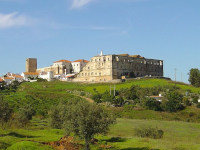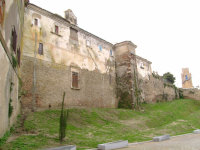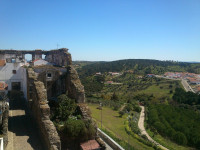Background

Its construction is related to the installation of the Military Order of Saint Benedict of
Avis
in the Alentejo region.
The primitive human occupation of the region dates back to prehistoric times, as can be seen from the presence of the megalithic complex at Herdade da Ordem de Avis.
The medieval castle

At the time of the Christian À época da Reconquest of the Iberian Peninsula, the lands of present-day Avis were donated, in 1211, by King Afonso II of Portugal (1211-1223) to the Militia of the Freires of Évora (founded in 1175), on the condition that they populate them and build a castle to defend the place. The works would take place between 1214 and 1223, attributed to its first Grand Master, D.Fernão Anes, with the friars transferring the headquarters of their Order here, later called the Military Order of São Bento de Avis or, simply, the Military Order of Aviz. The original Convent building was erected in the first half of the 13th century.
It was after the accession of John I of Portugal, Master of Avis, to the throne that the name of the town became associated with the History of Portugal, with the Order becoming dependent on the Crown.
From the 19th century to the present day

When the religious orders were abolished in Portugal (1834), the Military Order of Aviz had 18 towns, 49 commanderies and 128 priories in its domains. From then on, this heritage was dissolved, and the dependencies of the main Convent in Avis were sold to private individuals. At the time, the City Hall acquired the residence of the Order's masters, installing the Municipal Palace there. No information was found about the fate of the castle during this period, which, if abandoned, must have fallen into ruins.
The remains of the castle are listed as a National Monument by Decree of June 16, 1910. Of the six original towers of the town's walls, only three remain: São Roque, Santo Antônio and Rainha.
Features
Avis Castle is an example of medieval military architecture, with a fortification and urban
setting. It is located on top of a hill, dominating the surrounding valley and allowing you to
enjoy a beautiful landscape. The walls are made of granite and shale masonry.
The site consists of walls of which traces remain on the south, east and west sides of the settlement. Thus, it is possible to observe three quadrangular towers (of the Queen, of Santo Antônio and of São Roque), two circular cubes and two bastions.
Events of the time
1210 - Testament of Sancho I,
by which the king exempts the clergy from military service, except in the case of a Muslim
invasion.
The king reconciles with the bishops of Porto and Coimbra.
1212 - Due to the conflict with the infantas and the non-compliance with
the will of Sancho I,
the pontifical judges excommunicated Afonso II of Portugal
and issued an interdict on Portugal.
1214 - June 27 - King Afonso II of Portugal
signs his testament in Coimbra,
a document considered one of the oldest texts in the Portuguese language.
1215 - June 15 – King John I
of England
is forced by his nobles to sign the Magna Carta,
which limits royal powers.
1217 - Start of the Fifth Crusade.
- Conflicts between Afonso II and the Holy See resumed, because the
Portuguese monarch intended to maintain the
exercise of fiscal and judicial power in the subjugated territories, not accepting the almost
total exemption of the clergy.
1220 - By order of King D. Afonso II of Portugal
the first Pesquisas
were carried out in Portugal.
1225 -In the Bay of Biscay, near Gascony,
the Portuguese caravel Cardinal is
captured and imprisoned by the English naval contingent.
1238 - Conquest of Mértola by the Kingdom of Portugal.


